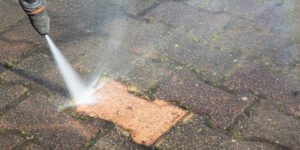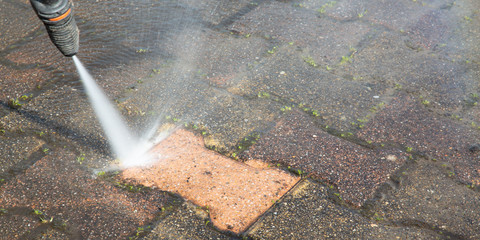Pressure Washing is a cleaning technique that utilizes pressurized water to remove stubborn dirt, mildew and grime from surfaces around your home. It is also a useful tool for restoring older or fragile exteriors.
However, the heating element in power washing poses a risk to heat-sensitive materials like vinyl siding. To prevent this, soft washing is a popular alternative that utilizes lower water pressure with cleaning chemicals to effectively clean delicate surfaces. Visit Website to learn more.
Pressure Washing is a powerful cleaning technique that uses a high-volume of water stream to remove dirt, grime, mildew and other contaminants from various surfaces. It is particularly effective in removing stubborn stains and in reaching crevices where regular cleaning methods might fail. It is typically faster and more efficient than traditional cleaning methods, allowing you to clean larger surface areas in less time.
The force of the water stream can cause damage to certain materials, so it is important to choose the right settings and adjust the technique based on the type of surface being cleaned. It is also important to prioritize safety and wear protective clothing, including gloves, goggles and long sleeves. Never use a pressure washer on ladders and be sure to cover electrical outlets to prevent electrocution.
It is also important to note that the chemical solutions used in pressure washing may raise environmental concerns and require proper disposal. Therefore, it is best to use this method in conjunction with other cleaning techniques where possible.
Using a pressure washer is a quick and effective way to clean a variety of outdoor surfaces. It is recommended that you use a detergent and hot water for the best results. Always spray at a 45-degree angle to the surface to avoid damaging it. It is important to work in overlapping sections and rinse thoroughly to prevent streaking. Remember to take breaks when using the pressure washer, especially if you are working on large surfaces. It is also a good idea to choose a day with mild weather so that your washing job dries quickly. Be especially careful around heat-sensitive exteriors, such as vinyl siding and painted surfaces.
Removes Allergens
Allergens like pollen, mildew, mold and dust mites thrive on outdoor surfaces and can cause sneezing, itchy eyes, and other respiratory problems for allergy and asthma sufferers. These allergens collect on a wide variety of surfaces, including patios, decks, siding, fences, and driveways. Pressure washing uses high-pressure water sprays to effectively clean and disinfect these surfaces, eliminating the mold, mildew, and dirt that accumulates on them. As a result, pressure washing is an effective way to improve the air quality around your property and help you breathe easier.
Allergies are a significant health concern for many homeowners, with symptoms often worsening during peak allergy seasons. These allergens often cling to outdoor surfaces, making them easy to bring into the home through open windows and doors or by clinging to clothing or shoes. Pressure washing removes these allergens from outdoor surfaces, significantly reducing the amount of allergens that infiltrate indoor living spaces.
Additionally, pressure washing removes organic material that can attract pests, making it an effective preventive measure against pest infestations. In addition, this cleaning method helps to eliminate the moist conditions that promote the growth of fungi that attract mold and mildew.
To maximize your allergy-fighting efforts, make sure to schedule regular pressure washing services. A professional cleaning service will have access to more powerful equipment and specialized cleaners that are able to reach deep into cracks and crevices, where most allergens hide. Additionally, they will know how to rinse thoroughly without causing damage to your outdoor surfaces. When performing your own pressure washing, be sure to work in sections and clean higher areas first. This will prevent allergens from dripping onto areas that have already been cleaned and can reduce your cleaning time.
Prevents Slippery Surfaces
Various organic growths, like algae and moss, thrive in damp areas and can cover sidewalks, patios, decks, and driveways in slippery films that pose slip-and-fall risks. Pressure washing blasts these growths away, removing their moisture and making surfaces less slick. The forceful water stream also carries kinetic energy that can break the bonds between surfaces and contaminants, expediting removal. When appropriate, detergents and cleaning solutions are added to the mix, further improving cleaning efficiency.
Oil stains and spills settle into porous concrete surfaces, leaving dark, unsightly marks that degrade the surface and can create unsafe conditions for pedestrians. Pressure washing removes these materials, restoring the natural texture of concrete and preventing costly repairs. In addition, high-pressure washing equipment can be adjusted to provide the correct dilution rate for specific types of cleaners.
Mold, mildew, dirt, debris, and organic growths deteriorate exterior surfaces and accelerate rot or corrosion. Surfaces that are exposed to prolonged moisture and sunlight may develop irreversible damage. Pressure washing removes these contaminants and helps prevent costly repairs, saving homeowners money over time. A clean exterior enhances the look of a home, making it more attractive to neighbors and potential buyers. Driveways and sidewalks become aesthetically pleasing again, while brick and stone walls regain their original color. Stuccoed or painted surfaces lose their color and begin to peel, requiring frequent repainting.
Preparation for Painting
Pressure Washing is a great way to prepare the surface for painting. It removes dirt and other debris from the surface, as well as stains and mildew. It also gives the paint a clean, even surface to adhere to. This will prevent peeling and cracking, and it will extend the life of your paint job.
Before starting any cleaning process, it is important to follow the manufacturer’s instructions for the cleaner you choose. It is also a good idea to wear safety gear, like goggles and gloves. Lastly, it is important to consider any plants or other features on your property that could be affected by the high-pressure water and cleaning solutions. If necessary, you should cover or move them. This will protect them from damage and ensure that the washing is done properly.
If you are planning on painting your exterior, hiring a professional is the best way to ensure that your surfaces are cleaned correctly and safely. Professionals have the experience and equipment to handle a variety of surfaces, as well as challenging stains. They can also identify and address any underlying issues that may require attention before proceeding with the painting. A thorough cleaning by a professional can double your paint’s lifespan, saving you time and money in the long run.
Removes Ice and Snow
Pressure washing can be a great way to remove ice and snow before it causes damage. When used on a low pressure setting and with the proper detergent, it can also be used to remove oil stains. This can be especially helpful for surfaces like driveways and sidewalks, which become dangerous when icy.
It can also help deter pests, such as spiders and wasps, that build nests in eaves and other difficult to reach places. The forceful water stream disrupts their habitats and makes it harder for them to return. In addition, pressure washing can be a great option for cleaning delicate fabrics, such as awnings and outdoor cushions. The warm water helps to gently clean without damaging them, and it can be a safe alternative to chemical solutions that could harm the fabric.
Clogged gutters can cause ice dams, which can lead to roof and siding damage. A thorough pressure wash can clear out leaves, twigs, and other debris to prevent this problem.
Regular winter pressure washing can also make spring cleaning less daunting. Mold, mildew, mud, and other substances can easily reappear on surfaces that aren’t regularly cleaned, and moisture from melting snow and ice can exacerbate existing problems. By regularly cleaning exterior surfaces, you can avoid this issue and prolong the lifespan of your home’s siding, roof, and other materials.
It’s important to note that using a pressure washer in freezing temperatures can be dangerous, and it’s best left to professionals with the right equipment and knowledge of proper safety measures. It’s also important to keep in mind that different surfaces require varying pressure levels and detergents, so be sure to adjust the settings accordingly. It’s also a good idea to test the pressure on a small, inconspicuous area before applying it to any surfaces.












